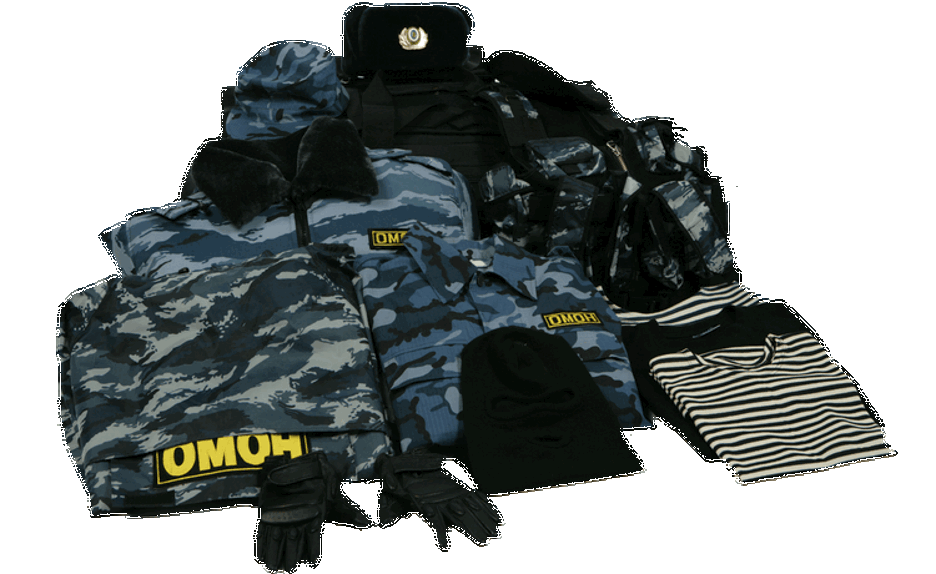Filed Under: Material culture > Arts or design > OMON Uniform
OMON Uniform

Anyone who has attended a street protest in post-Soviet Russia has seen first-hand the light blue uniforms of the OMON, the special forces of the Russian police (in Russian, the acronym stands for Otriad militsii osobogo naznacheniia). The name was first used by the White Army under Admiral Aleksandr Kolchak (1874-1920), then resurrected in 1988, when mass unrest spread from the Eastern Bloc to the peripheries of the Soviet Union itself.
The first OMON squads were set up in Moscow, Leningrad, Minsk, Riga, Vilnius, and Kyiv. After the fall of the Soviet Union, OMON squads appeared in major cities throughout Russia as an elite division of law enforcement, specially trained to respond to mass civil unrest. The now-iconic light blue uniforms were introduced in 1994 as OMON’s urban camouflage, with a more traditional green camouflage reserved for field operations. Soon thereafter, OMON became a regular feature of national and international news as squads from around the country were deployed to the First and then the Second Chechen War, where they were accused of many human rights abuses and civilian atrocities. Journalist Anna Politkovskaya (1958-2006), for instance, reported on OMON Lieutenant Sergei Lapin’s torture and forced disappearance of a Chechen student in Nezavisimaya gazeta prior to her own assassination by unknown assailants in 2006. That same year, the European Court of Human Rights found OMON guilty of massacring an entire Chechen family, including a pregnant woman, a one-year-old child, and an elderly man.
Amid mounting accusations, OMON’s presence in Russia only grew. In Yekaterinburg in 1998, for instance, a peaceful protest of students demanding that higher education remain free of cost turned into a bruising battle between the unarmed students and special forces in light-blue camouflage and riot gear. Throughout the post-Soviet era, OMON and its light blue uniforms have acted as a literal cordon marking the edges of the public sphere. As political violence has become increasingly common, OMON’s mandate has expanded. It counted 7,000 members in 1988, 12,000 in 2003, and 25,000 in 2014. As OMON grew over those years, the public sphere shrank, seemingly in inverse proportion.
The first OMON squads were set up in Moscow, Leningrad, Minsk, Riga, Vilnius, and Kyiv. After the fall of the Soviet Union, OMON squads appeared in major cities throughout Russia as an elite division of law enforcement, specially trained to respond to mass civil unrest. The now-iconic light blue uniforms were introduced in 1994 as OMON’s urban camouflage, with a more traditional green camouflage reserved for field operations. Soon thereafter, OMON became a regular feature of national and international news as squads from around the country were deployed to the First and then the Second Chechen War, where they were accused of many human rights abuses and civilian atrocities. Journalist Anna Politkovskaya (1958-2006), for instance, reported on OMON Lieutenant Sergei Lapin’s torture and forced disappearance of a Chechen student in Nezavisimaya gazeta prior to her own assassination by unknown assailants in 2006. That same year, the European Court of Human Rights found OMON guilty of massacring an entire Chechen family, including a pregnant woman, a one-year-old child, and an elderly man.
Amid mounting accusations, OMON’s presence in Russia only grew. In Yekaterinburg in 1998, for instance, a peaceful protest of students demanding that higher education remain free of cost turned into a bruising battle between the unarmed students and special forces in light-blue camouflage and riot gear. Throughout the post-Soviet era, OMON and its light blue uniforms have acted as a literal cordon marking the edges of the public sphere. As political violence has become increasingly common, OMON’s mandate has expanded. It counted 7,000 members in 1988, 12,000 in 2003, and 25,000 in 2014. As OMON grew over those years, the public sphere shrank, seemingly in inverse proportion.